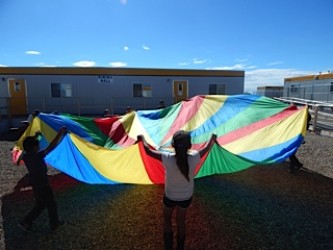Article Origin
Volume
Issue
Year
In the tight community of Siksika Nation, the Bow River flood of 2013 was a devastation that impacted everyone, some more so than others. Nearly two years later, the Nation is still dealing with the effects suffered by the disaster, including the psychosocial aspect of the event.
“It was the worst disaster that Siksika has ever had,” said Darlene Munro, program manager of the Dancing Deer Disaster Recovery Centre, “but nobody at the beginning looked at the human aspect of the rebuild.”
Munro realized the urgent need for individual mental health response.
“We saw that people were devastated and traumatized by what occurred,” she said.
Psychologist and Blood Tribe member Wilma Spearchief, along with other contracted therapists, began working closely with the DDDRC and Siksika Health Services to provide assistance in the area of mental health.
“There are some who have not sought help (previously) and those are the ones we’ve been tracking and following up with in the neighbourhood,” said Spearchief.
The disaster had initially displaced nearly 1,000 Siksika Nation members on June 20, 2013, and as a result, people are still going through a period of mourning, says DDDRC family support worker Waylon Black.
“It’s really like a death... in some cases, the death of dreams. Many people have spent the majority of their lives in their homes and have created memories. Some of the farmers and ranchers affected and those who have really built up their properties had dreams for the future, for their children and grandchildren. When all of that is wiped out in a matter of hours, it’s a devastating reality,” he said.
With respect to the post-behaviour observed among some of the evacuees, Spearchief says that the stress, unpredictability, and unknowing have left some people turning to alcohol as a coping mechanism. Others have been diagnosed with clinical depression. Spearchief has also noticed that for those struggling with health problems already, especially among the seniors, the outcome of the event has compounded these issues. Dealing with isolation has also been an issue.
While Spearchief has not diagnosed anyone with Post Traumatic Stress Disorder, she finds individual resiliency key.
“Because a disaster affected you, it doesn’t necessarily mean you have a mental health problem. Everyone will be affected but it depends on people’s resilience and survival of how they coped before the flood. We’ve had people who had done really well and accessed little support and others who needed a little bit more,” she said.
Black and Spearchief both suspect that it will take years to fully get over this experience, if at all.
The DDDRC has been a one-stop resource and continues to advocate for those impacted by providing outreach services, case management, counseling and referrals, as follow up work to the rebuild efforts.
Youth and adult programming, community gatherings, and partnerships have helped the organization become a first responder in the community.
Current financial support for DDDRC comes from the Alberta Health Services Psycho-Social Impacts of the Flood Funding.
Photo Caption: Youth evacuees participate in programming held by the Journey of Hope Program from Save The Children Canada, in partnership with Dancing Deer Disaster Recovery Centre.
- 1228 views

